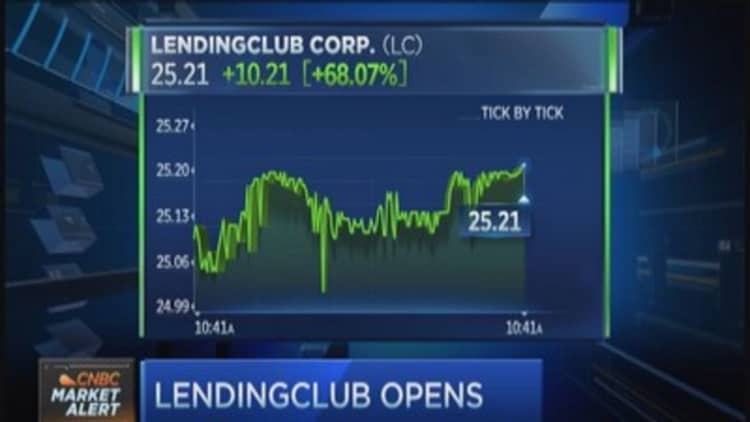LendingClub co-founder Soul Htite flew to the U.S. from China last week for the online lender's stock market debut on Dec. 11. But he wasn't just in town to celebrate with his former colleagues at the New York Stock Exchange.
Htite was also visiting prospective investors in his latest venture Dianrong, known as the LendingClub of China. One of those meetings was with mega-tech investor Tiger Global, which led a significant, yet-to-be-officially announced, financing round in Dianrong. Tiger's previous deals range from Facebook in the U.S. to Albaba in China and Flipkart in India.
"There are investors eager to get into the China wave," Htite said in an interview in San Francisco, where he's meeting with venture capital firms after a four-day stay in New York.
Read MoreLendingClub's big VC winners
Htite founded Dianrong (formerly SinoLending) in 2012, five years after LendingClub got off the ground, but the newer company is already bigger in terms of head count. Dianrong has 975 employees versus LendingClub's 742 at the end of September, according to the IPO prospectus.
While Dianrong promotes itself as the LendingClub of China, the business is quite different, as the Chinese financial services industry is far less developed. According to Htite, his company has been helping to build the banking infrastructure in China, a feat never asked of LendingClub in the U.S.
LendingClub helped pioneer peer-to-peer, or marketplace, lending. Rather than serving as a bank that uses insured consumer deposits to make loans, the company developed a marketplace to bring together borrowers with individual and institutional investors. The capital comes from investors, with LendingClub underwriting and servicing the loans.
At LendingClub, Htite was vice president of engineering until late 2010. He and LendingClub Chief Executive Officer Renaud Laplanche worked together at Oracle before launching the online lender.
Shares of LendingClub have surged 86 percent to $27.90 since the IPO, valuing the company at $10.1 billion.
Read MoreCan LendingClub transform banking as we know it?
LendingClub makes money by charging a fee of about 5 percent on every loan issued. It's a Web-based model that's taking on the brick-and-mortar banking system with lower rates than consumers can typically get from credit cards.
In China, there's no ubiquitous banking structure. Little credit is available for small businesses and aspiring entrepreneurs, and given the country's explosive growth, demand for capital is insatiable. So in addition to providing its own platform for borrowers and investors to connect, Dianrong is partnering with banks that are using the company's technology to expand their lending capabilities.
LendingClub soars

"He's creating an industry because it doesn't really exist today," said Charles Moldow, a partner at Silicon Valley venture firm Foundation Capital, which bet early on LendingClub. "In a very uncertain environment, he built one of the leading platforms, which is not easy to do."
Moldow, who published a 35-page white paper earlier this year on what he calls a trillion-dollar opportunity in marketplace lending, is a personal investor in Dianrong.
Bank of Suzhou announced in October that it's using Dianrong's platform, and two other banks are also on board. Dianrong helps design the product, puts risk modeling in place and services the loans. It gets paid between half a percent and 1 percent of the loan amount.
Read MoreChina's economic growth could slow in 2015
"We are creating Internet-friendly products, so borrowers can apply directly," Htite said. "We built relationships with some very prominent names in China."
It will take time before we know whether Dianrong's risk modeling and underwriting is accurate or effective. After all, many of its customers are receiving their first-ever loans. How they perform in a market with all sorts of volatility—financial, economic and political—will go a long way to determining if the online lending model and Dianrong's business can flourish.
And while Dianrong is trying to mitigate regulatory risk by working directly with large Chinese financial institutions, there are still many rules to be potentially written on the legality of the peer-to-peer market. "The Chinese P2P lending industry is in its infancy, unregulated and without infrastructure," said a September report from the Nomura Research Institute,
About 120 of Dianrong's 975 employees are in technology, with 200 in risk management and the rest in operations and sales. Dianrong has 14 offices and is opening another in Hong Kong in March.
Dianrong is far from the only lending marketplace in China. In May, industry research group Lend Academy, named Dianrong as one of the eight most-important Chinese peer-to-peer lenders, with CreditEase being the biggest. Celent, a research and consulting firm, estimates the market in China will reach $7.8 billion in 2015 from $940 million in 2012.
Htite, who was born in Canada and never lived in China before starting Dianrong, is getting as much support as he can from big domestic financial players. The start-up raised money in October from Sun Hung Kai & Co., an investment company in Hong Kong, and has brought in tens of millions of dollars from Northern Light Venture Capital, which has offices in Hong Kong, China and the U.S.
Expect to hear more on the fundraising front soon, especially after Htite's whirlwind tour through New York and Silicon Valley.


